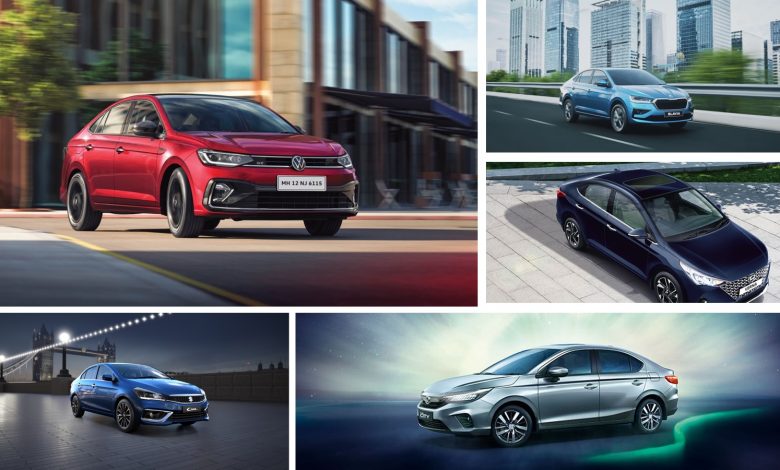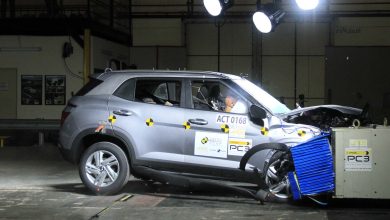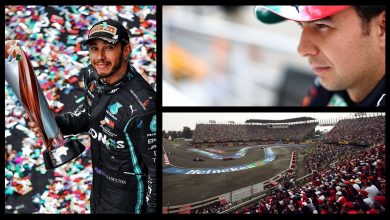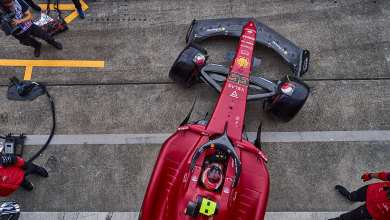
India’s saloon segment has always been one in which the competition has been supremely fierce. But, the shift to SUVs started wrecking this petrol head segment quite seriously. For European brands like Skoda and VW along with Honda, this segment was more like their bread and butter owing to no sub-compact SUV offering from them. Although, we recently saw the launch of two cousin cars built on the same platform, which are the Skoda Slavia and the Volkswagen Virtus. Both are built on the made-for-India MQB-AO-IN platform, so the differentiation between the two is minimal and they are effectively cousin cars. This along with the buzz of the upcoming Ciaz offers a much needed breath of fresh air to the segment.
However, they are not the only two options for potential saloon customers in the Indian market, and the saloon segment is actually hotly contested between 5 cars- the VW Virtus, Skoda Slavia, Hyundai Verna, Honda City and the Maruti Ciaz. Which one comes out on top? We will compare all across various segments to find out the answer.
The Mechanical Aspect
It really is all about drive and power in the end after all! The Slavia and Virtus are mechanically identical, and both have an option between a 1.0L and a 1.5L petrol engine which produces 113HP and 150HP respectively. On the transmission side, there is an option between a 6-speed manual gearbox and a torque converter automatic on the 1.0L and a DSG automatic on the 1.5L. There is no diesel on offer here.
Coming over to the rest, the Honda City has a 1.5L petrol engine producing a total of 121HP, and is mated to either a 6-speed manual or a CVT automatic. There is a diesel engine option as well which is 1.5L producing 98HP though only comes with a manual gearbox as standard. The Ciaz has just one petrol engine in the form of a 1.5L naturally-aspirated unit which produces a mere 104 horses, the least of any of the competitors here and the transmission options are also extremely weak, with only a 5-speed manual or a 4-speed torque converter automatic on offer.
The Verna has the most flexibility, with 3 engines- a 1.0L turborcharged petrol unit, a 1.5L naturally-aspirated petrol unit and also a 1.5L diesel. The petrol units have a power output of 118HP and 113HP respectively for the 1.0L and the 1.5L, while the diesel has a power output of 113HP. The powertrains also differ, with the 1.5L petrol getting a 6-speed manual with a CVT gearbox as an option, the 1.5L diesel getting a 6-speed manual and a torque converter automatic and the 1.0L only getting a 7-speed DCT transmission.
[tie_slideshow]
[tie_slide]

[/tie_slide]
[tie_slide]

[/tie_slide]
[tie_slide]

[/tie_slide]
[tie_slide]

[/tie_slide]
[tie_slide]

[/tie_slide]
[/tie_slideshow]
For the petrol heads, the VW cousins win out this round on the basis of power alone. What’s more is that we know how good the Slavia is to drive with the 1.0L turbo so that would be the same if not better in the GT trim of the Virtus. The Verna also doesn’t fall behind giving the consumer a multitude of choices to choose from, something which the others don’t do. The City has a great power output even without a turbocharged engine, while the Ciaz lags behind massively in this segment with an underpowered engine and bad transmission options. Although it is the car to get if efficiency and economy is your preference which is the reason why it sells so much.
The Pricing
Unsurprisingly, it is the Ciaz which wins this out by a long way, with its base model being almost Rs 70K lesser than the base model of the nearest competitor, the Verna. The City sits midway with a starting price of Rs 11 lakh while the Slavia is the one most likely to burn a hold in one’s pocket, considering how even though it starts at 10.5 lakhs, it goes all the way up to 17 lakhs for the top-end variant, which is certainly a pretty penny to pay!
The Gizmo War
The Slavia and Virtus were released recently, and as recency bias goes they both get an upper hand due to having the latest tech onboard. This includes an all-digital instrument cluster, a sunroof, 10″ infotainment system, cruise control, climate control, ventilated seats and more. Both are extremely spacious as well, thanks to the long wheelbase in the MQB-AO-IN platform. The cabin looks quite elegant, which is also a selling point for both cars.
The Honda City also has its fair share of gizmos, and shares most of them with the Slavia and Virtus. Where the City has an edge is with a few of its unique features such as Lane Watch Camera and a handling assist, both of which are built into the car. The rest of the feature list is very similar to the Virtus and Slavia, with the usual sunroof, climate control, cruise control, air filter, rain-sensing wipers and more. The interior design doesn’t scream innovation and is quite simple, though if it ain’t broke, why fix it?
The Verna also has similar spec sheet, though its cabin looks the most gizmo-friendly and has a lot of features packed into it. There is the usual climate control, ventilated seats, keyless entry and more, though it also has push-button start and a massive infotainment system in the centre console. The cabin also looks the most modern out of the lot, which will certainly attract buyers towards it!
[tie_slideshow]
[tie_slide]

[/tie_slide]
[tie_slide]

[/tie_slide]
[tie_slide]

[/tie_slide]
[tie_slide]

[/tie_slide]
[tie_slide]

[/tie_slide]
[/tie_slideshow]
The Ciaz also has a similar spec sheet but unfortunately doesn’t have anything additional on top of it. Adding to that, the cabin also doesn’t really have that wow factor which the others have, so it loses out in this regard. Hence, this round is a tie between the Verna and the VW twins, with the City behind and the Ciaz last.
The Safety Front
The Honda City has done something remarkable, for at its launch back in 2020 it offered 6 airbags as standard across the entire range, be it base model or the top model! There are also additional features like lane watch assist, rear view camera, hill hold assist, ABS+EBD, tyre pressure monitoring system, an auto-dimming rearview mirror and more which set it apart from the rest.
The VW twins also come with 6 airbags as standard, and also have other features like hill hold, multi-collision brake, a rear view camera, TPMS, and more. Given the past of German vehicle’s build quality, it won’t be far behind if not better than the best in the segment, the Honda City.
[tie_slideshow]
[tie_slide]

[/tie_slide]
[tie_slide]

[/tie_slide]
[tie_slide]

[/tie_slide]
[/tie_slideshow]
The Verna has a unique Emergency Stop Signal system that flashes the rear brake lights to help avoid getting rear-ended, and also has 6 airbags, TPMS, pinch guard on all windows and more. The cabin size is also a touch small, which doesn’t help with comfort at all. The 6 airbag version even has a 5-star ASEAN NCAP safety rating.
The Ciaz is immensely lacking here, as it is the only one here with just two airbags. The rest of the safety features list isn’t any better either, and it is severely lacking in the safety regard. Hence, the City comes out on top here as well. Although, it is noteworthy that the Ciaz still managed a score of 4 stars at the ASEAN NCAP test.
The Final Verdict
The final verdict rests upon the fact as to which car provides the most bang for your buck. It is also hugely dependent on the user and their needs. The Ciaz is only for those desiring low maintenance costs as it has Maruti’s reliability and fuel efficiency. It also has a cheap starting price as compared to the others.
The VW twins have the most power available, but are on the expensive side. They have a lot going for them and their main competition is in the form of the City. The Virtus and the Slavia are a premium offering that will definitely make you feel they are from a segment above. The City does the same in terms of the interior feel but the lacklustre design might not please everyone. It still is Honda City which is the go to choice for those desiring Japanese quality and reliability. The Verna is no slouch but does lose out in the overall comparison between it and the City as it is quite old now and the Honda having some crucial advantages which set it apart.
All things considered, the win has to be split between the VW twins and the City. Though the Slavia and Virtus may be the new kids in the market, the undisputed segment leader is undisputed for a reason, though if Honda don’t step up their game soon then their reign could be under threat.





One Comment